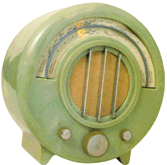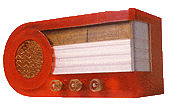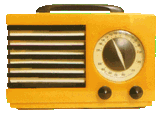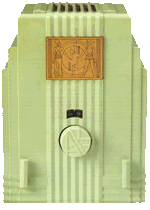The Rise of the Bakelite and Catalin Radio in the US during the 1930sBy: Louis Vloedbeld Introduction: Social Workers in the US reported during the depression that families would give up furniture or bedding or most anything rather than their radio. The radio offered entertainment, something to fill the time, or a sustaining emotional link with a larger community.(1) Possessing a radio had an enormous cultural effect as well. The radio generated an interest among people for all kinds of cultural activities they had not been able to be part of. The radio could and create a common bond between the American people, this common bond could appear in cultural programs on the radio, sport programs, comedies but also political programs appeared. Very famous political radio programs were the speeches from president F.D. Roosevelt. FDR frequently used the radio to address the American people. By this the president almost closed the gap between the US people and US politics in Washington DC. Because of the radio, national broadcasting networks emerged like: NBC (National Broadcasting Company) and CBS (Columbia Broadcasting System). There were lot of discussions going on if the radio programs should be controlled. The establishment of the FCC (Federal Communication Commission) in 1934 brought no dramatic changes in the control of radio programs. The FCC proved more interested in preventing broadcasting offences than in establishing positive requirements for the type and quality of radio fare, an attitude that allowed neither constructive guidance nor threatening control.(2) Radio was never real government controlled, it functioned merely on a commercial basis. In this essay I want to look to the advantages of the bakelite and catalin radio during the 1930s. I also want to describe how the outlook of the radio changed during the 1930s by styling and design Technological advantages made on the outside of the radio.One of the technological advantages was the use of bakelite and catalin instead of wood or steel for radio cabinets. The use of wood and steel for radio cabinets made radios very expensive. Bakelite was often used to imitate wooden materials and products, for instance radio cabinets, cigarette boxes, lamp cases, and so on. In the wealthy part of the American society there was some resistance against bakelite, it was seen as cheap and nasty. This vision and reputation on bakelite was made possible because other plastics were not well used in products before. In fact bakelite had an unfair reputation in the more wealthy parts of American society. The Bakelite Corporation led the way in convincing manufactures to beautify products with plastic.(3)
The attractive side to these materials, bakelite (in powder form) and catalin (in fluid form), was the fact that it could be moulded. Bakelite and catalin radio cases were designed very easily, designers or architects made a mould drawing, which became a mould. So, in fact the biggest technical revolution for the bakelite and catalin radio was that a bakelite or catalin radio case could be moulded, not just one but hundreds of them. But it was not until the mid-Thirties that new methods in plastic-moulding technology permitted the use of these fabulous new materials for anything as large, and complicated, and glamorous as radio cabinets.(5) The production, in fact the moulding, of radio cabinets made the radio cheap, it needed less hand labour than it was the case with wooden radio cabinets which couldn't be moulded. But making moulds meant in fact that you could make different kinds, forms and patterns of and in radio cabinet along the assembly line, which was not possible with wood. This was an other technical revolutionary aspect to the making of bakelite or catalin radio cabinet. It was also possible to make bakelite and catalin radio cabinets in different kinds of colours by putting colour material to the bakelite and catalin material during the process of moulding. So in fact you could say that the technical process, mostly on the exterior side of the radio production, made it possible that a lot of Americans, despite the depression, could afford a radio. The outside styling and design of the bakelite and catalin radio.The styling and design of the radio was also very important. Not only the American ear wanted something to hear, the American eye also wanted to see a nice and beautiful radio. A radio was during the 1930s just as important as the television is today. During the 1930s the radio was a major and important part of the furniture of almost every American household. Most radios in the US were build in a way that they really were part of the furniture set. The Thirties was a period that saw an unprecedented interest in the art and design of common objects. The power of the industrial design movement was at its peak, and the influence of machine-age aesthetics and the popularity of the streamlined style were widespread.(6) The forerunners of the industrial design movement in the US were: Raymond Loewy, Harold van Doren, Norman Bel Geddes, Henry Dreyfuss and Walter Dorwin Teague. All these men had a different background, some had an art background, some had a commercial background. These men used their talent in giving products a total new outlook by styling and design, hoping that these products would sell better. The new styled and designed products should attract the people and so trying to convince these people to buy it. But not only the styling and design of products was important in trying to convince people to buy these new styled and designed products, but also the advertisements of these bakelite or catalin products was important as well. But it was very hard during the 1930s trying to convince people, who were struggling to survive, to buy new articles in a time of harsh economic depression. During 1933 an 1934 "Modern Plastics and Sales Management" ran a series of advertisements focusing on individual designers and their bakelite products. Each ad featured a single product, each contained a small photograph and capsule biography touting the designer as celebrity, and each quoted the great man himself on the virtues of modern design.(7) During the 1930s American designers designed radios along the lines of the Art Deco movement. Also the influence of the automobile and airplane industry was great. The streamlined effects and forms on radios were in fact borrowed from the automobile and airplane industry. With bakelite and catalin the designers could precisely reflect the spirit of the Thirties. Radios were designed in bright new colors that made them function as decorative objects in their own right. In other words bakelite or catalin and designing reinforced each other.
The bakelite and catalin radios were very popular at the end of the 1930s. The key to the importance of these radios lies within the framework of what is probably one of the most brilliant and successful adaptations or combinations of material, form and function that has ever been made in the field of the industrial arts. It was a happy marriage to be sure and one that was joined with great enthusiasm by both the plastics and radio industries. It is within the dynamics of this interplay between color and form that the magic occurs and that the radios transcend the realm of ordinary household appliances and achieve status as objects of art. (9) Despite the depression, radios during the Thirties did have a total new and fresh outlook at the end of the decade. Technique, styling, functionalism, art, candy colors and design changed the radio rapidly during the 1930s. The radios of the 1930s were in fact very modern and it looked if they were ahead of their time. The radios at the end of the 1930s embodied the elements of the popular modernism in the US. Possessing a radio in these times, was something which gave you social status. The very fact that someone possessed the latest design of radio was enough to generate a competitive one-upmanship among neighbors and even the ostentatious display of a big radio aerial in the roof was an indicator of your forward looking attitudes and thereby your position in the cultural pecking-order.(10) At the end of the 1930s lots of Americans could afford a second radio. Most of these second radios were very small and were not there for replacing the radio in the living room but more for the kitchen or the bedroom. These little or smaller radio sets were mostly build with a bakelite or catilin cabinet. The styling and design of the bakelite and catalin radios (Link: http:// www.accessone.com/~philn/search.htm)changed to whole attitude of the (US) people towards the radio. The radio became a symbol of art and reinforced the social status of the person who bought or possessed the radio. The transformation of the radio in the US during the 1930s.
The radio also reinforced the social status of the person who owned or bought such a new styled and designed radio. You couldn't hardly say that the bakelite or catalin radios (link: http:// www.accessone.com/~philn/)of the Thirties were products of that time because of the depression. The radios looked fresh, beautiful, because of their new candy like colors, the gloomy outlook and so on. Such a radio you would hardly compare to time of depression. But bakelite and catalin made it lots easier to style and design beautiful radios. And bakelite and catalin were much cheaper material than wood or steel and also in production. Bakelite and catalin radios could be assembled along an assembly line. Bakelite and catalin reinforced the outlook, the styling and design of the radio, which couldn't be done with wood and steel. America was the forerunner of styling and design of radios during 1930s though the Europeans were more specialized into the interior of the radio. Some major American radio producers of this time were: Emerson, Remler, Addison, Fada, Sentinel, Air King industries, and so on. For instance Harold van Doren was one of the well known designers who worked by the Air King industries and designed for instance a skyscraper-influenced bakelite radio for Air King in 1933. Most radios of bakelite appeared in the colors, brown, black green and red-brown, the more colored radios were made from catalin. But both materials made radios look like very gloomy. In 1936 Remler made a bakelite radio, along the lines of the Art Deco movement, with a little dog on it which president Roosevelt had. Most radio producers used as well bakelite or catalin material. Both materials were very durable, cheap and good to use.
|
 In the case of the
radio, bakelite and catalin were seen as a good
substitution for wood. Wood was often used by the wealthy
part of American society. But the imitation of wood by
bakelite was almost perfect. The best thing of all was
that a bakelite and catalin radio was much cheaper than a
radio with a wooden cabinet. Mostly during the depression
of the 1930s, bakelite and catalin material made it
possible for everyone to buy a radio for just $10,--
instead of $ 90,-- or so for a radio with a wooden
cabinet.(4) On the other hand bakelite
and catilin were and are very strong, durable, gloomy and
attractive material for designers. But what made bakelite
and catilin, as kinds of plastic material, very
attractive?
In the case of the
radio, bakelite and catalin were seen as a good
substitution for wood. Wood was often used by the wealthy
part of American society. But the imitation of wood by
bakelite was almost perfect. The best thing of all was
that a bakelite and catalin radio was much cheaper than a
radio with a wooden cabinet. Mostly during the depression
of the 1930s, bakelite and catalin material made it
possible for everyone to buy a radio for just $10,--
instead of $ 90,-- or so for a radio with a wooden
cabinet.(4) On the other hand bakelite
and catilin were and are very strong, durable, gloomy and
attractive material for designers. But what made bakelite
and catilin, as kinds of plastic material, very
attractive?  The Art Deco movement was build
upon different kinds of Art. Into this melting-pot of Art
went Machine-Age concepts, cubism, constructivism,
functionalism, kitsch, and many other new ideas derived
from the traditional art forms of Afrika, the Aztecs,
India, and Mexico: what came out was a completely new
variety of styles of radio, although these took some time
to become established. (8)
The Art Deco movement was build
upon different kinds of Art. Into this melting-pot of Art
went Machine-Age concepts, cubism, constructivism,
functionalism, kitsch, and many other new ideas derived
from the traditional art forms of Afrika, the Aztecs,
India, and Mexico: what came out was a completely new
variety of styles of radio, although these took some time
to become established. (8) At the
beginning of the 1930s the radios looked huge and not
very fashionable, there were just a few kinds and forms
of radios. This changed at the middle of the 1930s. With
the molding system of bakelite and catalin radios and the
possibility of coloring the radios the whole world of the
radio changed rapidly. Now it was possible to produce
hundreds of different and colored radios and not only a
few which was he case with wood. The bakelite and catalin
radios became more streamlined, gloomier, and
fashionable. Bakelite and catalin radios began to look
like real fashion items and items of art. Radio producers
started to use real architects and designers for
designing their own new radios. Some radios even looked
like cars, the buttons on a radio could look like a car
bulb, the radio tune could look like a car speedometer
and the loudspeaker of a radio could look like a front of
an automobile. The whole radio changed into an object of
art just in not more than ten years time throughout the
Thirties.
At the
beginning of the 1930s the radios looked huge and not
very fashionable, there were just a few kinds and forms
of radios. This changed at the middle of the 1930s. With
the molding system of bakelite and catalin radios and the
possibility of coloring the radios the whole world of the
radio changed rapidly. Now it was possible to produce
hundreds of different and colored radios and not only a
few which was he case with wood. The bakelite and catalin
radios became more streamlined, gloomier, and
fashionable. Bakelite and catalin radios began to look
like real fashion items and items of art. Radio producers
started to use real architects and designers for
designing their own new radios. Some radios even looked
like cars, the buttons on a radio could look like a car
bulb, the radio tune could look like a car speedometer
and the loudspeaker of a radio could look like a front of
an automobile. The whole radio changed into an object of
art just in not more than ten years time throughout the
Thirties.